Monolithic Power Systems Bundle
How Does Monolithic Power Systems Dominate the Power Management Market?
Monolithic Power Systems (MPS) has revolutionized the power management solutions industry, but how does this fabless semiconductor giant actually sell and market its innovative integrated circuits? From its humble beginnings in 1997, MPS has consistently pushed the boundaries of what's possible in power system design. This comprehensive analysis delves into the core of MPS's Monolithic Power Systems SWOT Analysis, revealing the strategies that have fueled its remarkable growth.
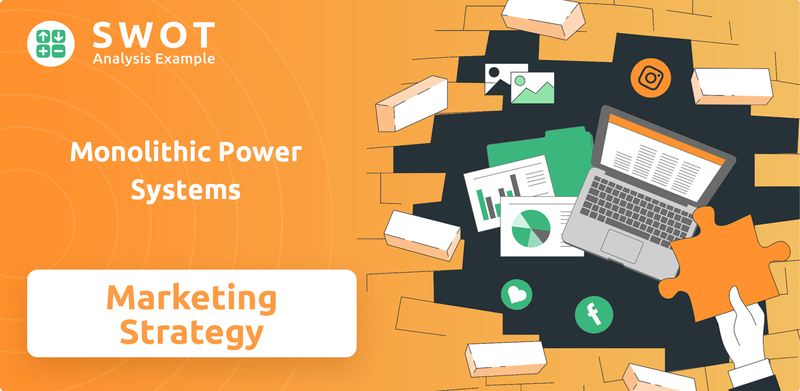
Understanding the sales strategy and marketing strategy of Monolithic Power Systems is crucial for investors, competitors, and anyone interested in the semiconductor industry. This deep dive will explore how MPS navigates the complexities of semiconductor sales, focusing on its approach to customer acquisition, product promotion, and market positioning. We'll also examine the company's MPS marketing campaign analysis and how it tackles MPS sales and marketing challenges to maintain its impressive Monolithic Power Systems sales performance.
How Does Monolithic Power Systems Reach Its Customers?
The sales and marketing strategy of the company, focuses on a multi-channel approach to reach its diverse customer base. This strategy primarily utilizes a blend of direct sales and an extensive network of third-party distributors and value-added resellers. The company's approach is designed to maximize market penetration and customer reach across various global regions.
The company's sales channels are strategically designed to reach key markets. The company directly targets Original Equipment Manufacturers (OEMs), Original Design Manufacturers (ODMs), and Electronic Manufacturing Service (EMS) providers. These efforts are concentrated in major global regions, including China, Taiwan, South Korea, Europe, Japan, Southeast Asia, and the United States.
The evolution of these channels reflects a strategic expansion to maximize market penetration. Strategic partnerships with major authorized semiconductor distributors globally, including Avnet, DigiKey, Future Electronics, and Mouser Electronics, are crucial for reaching a broader customer base in the Americas, Asia Pacific, China, and EMEA regions. These distributors play a significant role, contributing substantial sales revenue; for instance, in 2023, 42 authorized semiconductor distributors globally contributed $412.6 million in total sales revenue.
The company's sales strategy involves direct engagement with OEMs, ODMs, and EMS providers. This direct approach allows for tailored solutions and stronger relationships. This strategy is particularly effective in markets like China, which accounted for 51.3% of net sales in Q1 2025, and Taiwan, which accounted for 16.9%.
The company leverages a robust network of distributors to broaden its market reach. These distributors, such as Avnet, DigiKey, Future Electronics, and Mouser Electronics, are crucial for reaching a wider customer base. These distributors play a significant role, contributing substantial sales revenue; for instance, in 2023, 42 authorized semiconductor distributors globally contributed $412.6 million in total sales revenue.
Strategic partnerships, such as the one with Symmetry Electronics announced in 2025, expand the company's reach. These partnerships leverage specialized sales and engineering teams. This approach is particularly beneficial in the wireless and video semiconductor product distribution in the Americas.
The company utilizes e-commerce platforms through its distributors to enhance accessibility. This online presence is crucial for reaching a broader customer base. These platforms provide customers with easy access to a wide range of high-performance power solutions.
The company's sales strategy is a blend of direct sales and distribution channels. This approach allows for a wide market reach and specialized customer support. These strategies ensure the company can effectively promote its power management solutions.
- Direct Sales: Focused on key customers like OEMs and ODMs.
- Distribution Network: Partnerships with major distributors like Avnet and DigiKey.
- Strategic Partnerships: Collaborations to expand market reach, such as the Symmetry Electronics deal.
- E-commerce: Utilizing online platforms for broader accessibility.
Monolithic Power Systems SWOT Analysis
- Complete SWOT Breakdown
- Fully Customizable
- Editable in Excel & Word
- Professional Formatting
- Investor-Ready Format
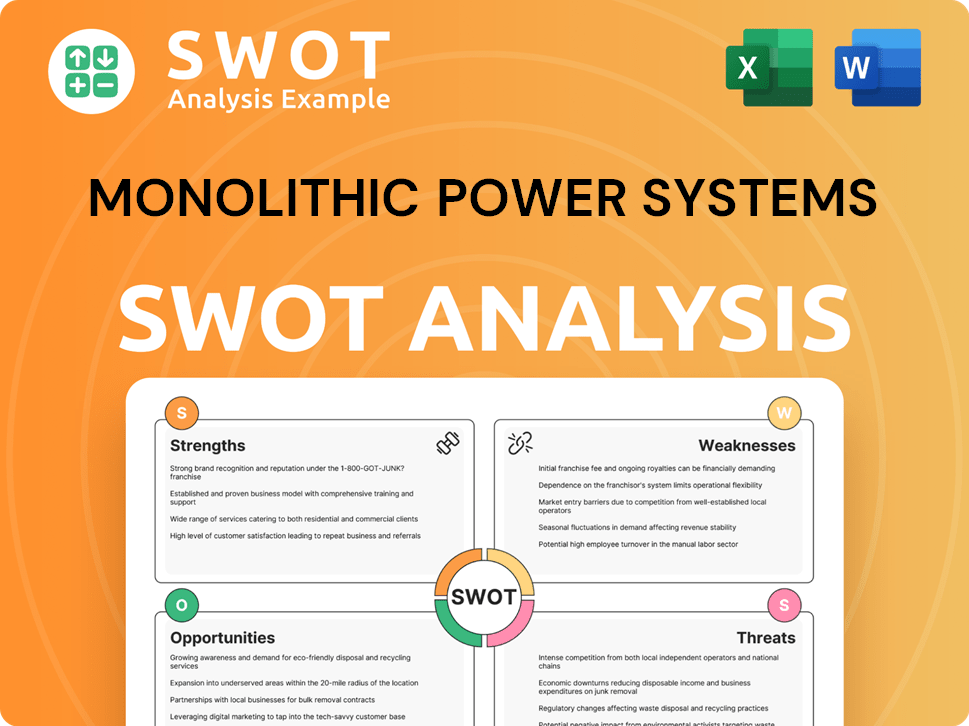
What Marketing Tactics Does Monolithic Power Systems Use?
The marketing tactics of Monolithic Power Systems (MPS) are designed to boost awareness, generate leads, and drive sales within the high-performance analog and mixed-signal integrated circuits market. Their approach emphasizes core strengths like system-level knowledge and semiconductor design expertise. Their strategies highlight the benefits of their solutions, such as improved efficiency and reduced energy consumption.
MPS focuses on showcasing its technical leadership and product advantages through content marketing. They utilize white papers, application notes, and technical webinars to reach their target audience of engineers and system designers. The use of marketing automation, like platforms such as Marketo, suggests a focus on lead generation and nurturing. Their investor relations website also plays a crucial role by showcasing financial results and growth.
The company engages in traditional marketing through industry events and technical conferences, where they can directly demonstrate their solutions. The 'mCar' is an example of a hands-on approach to demonstrating product capabilities. The company's marketing mix has evolved to support its transformation from a chip supplier to a full solutions provider, focusing on solving customer problems and adapting to market changes.
MPS likely uses content marketing to highlight its technical leadership and product benefits. This includes white papers, application notes, and technical webinars. Marketing automation tools like Marketo are likely used for lead generation and nurturing.
MPS participates in industry events and technical conferences to demonstrate its solutions. They use demonstrations like the 'mCar' to showcase product capabilities. This hands-on approach is designed to engage potential customers and partners directly.
The company has shifted from being a chip supplier to a full solutions provider. This change involves solving customer problems and adapting to market changes. This shift is supported by a strong understanding of their customer segments.
The investor relations website is a key digital hub for financial results and presentations. This indirectly supports marketing by demonstrating financial health and growth. Q1 2025 revenue reached $637.6 million, a 39.2% increase year-over-year.
The company's consistent growth across diverse end markets like Enterprise Data (up 121.7% in 2024), Automotive (up 4.9% in 2024), and Storage and Computing (up 2.1% in 2024) suggests effective targeting. Their sales strategy is focused on solving customer challenges.
MPS focuses on promoting its products as comprehensive solutions. This involves highlighting the benefits of their power management solutions, such as improved efficiency and reduced energy consumption. This approach supports their overall sales strategy.
MPS's marketing and sales strategy is multifaceted, combining digital and traditional approaches to reach its target audience effectively. The company focuses on demonstrating the value of its power management solutions through various channels.
- Content Marketing: Utilizing white papers, application notes, and webinars to showcase technical expertise.
- Marketing Automation: Employing tools like Marketo for lead generation and nurturing.
- Industry Events: Participating in conferences to demonstrate solutions directly to potential customers.
- Solutions-Oriented Approach: Positioning products as comprehensive solutions to customer problems.
- Financial Transparency: Leveraging the investor relations website to demonstrate financial health and growth.
- Targeted Market Segmentation: Focusing on key markets like Enterprise Data, Automotive, and Storage and Computing.
Monolithic Power Systems PESTLE Analysis
- Covers All 6 PESTLE Categories
- No Research Needed – Save Hours of Work
- Built by Experts, Trusted by Consultants
- Instant Download, Ready to Use
- 100% Editable, Fully Customizable
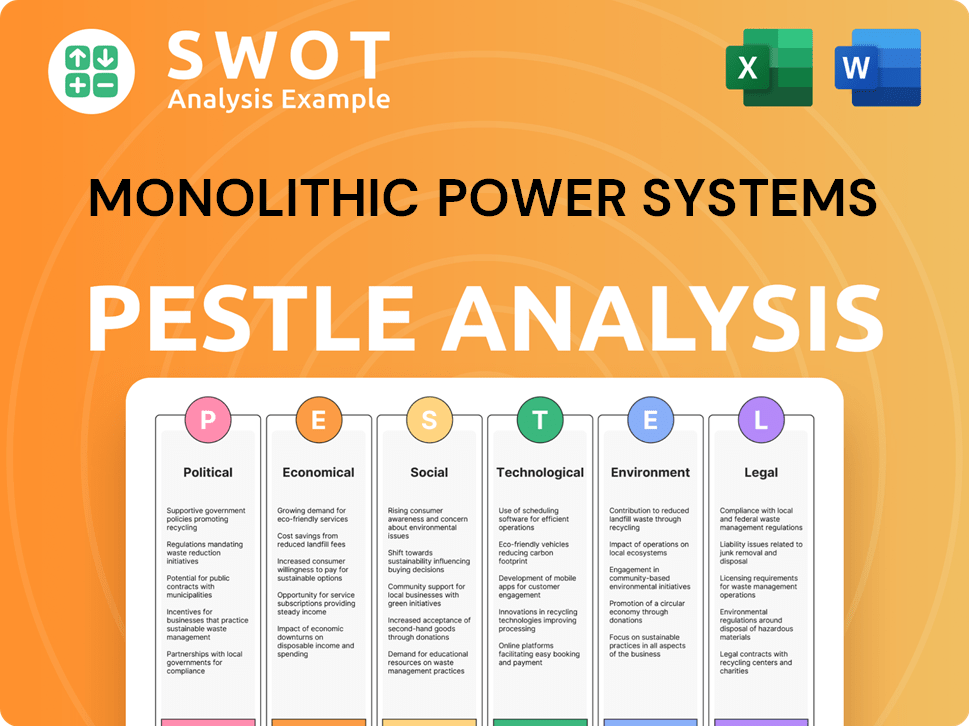
How Is Monolithic Power Systems Positioned in the Market?
The brand positioning of Monolithic Power Systems (MPS) centers on its identity as a leading innovator in high-performance power management solutions. The core message emphasizes efficiency, compactness, and ease of use, stemming from the ability to integrate entire power systems onto a single chip. This approach, pioneered by founder Michael Hsing, allows MPS to differentiate itself through solutions that offer higher power density, smaller form factors, and extended battery life, particularly beneficial in applications like data centers and automotive systems. This is a key element of their overall Growth Strategy of Monolithic Power Systems.
MPS targets electrical engineers and system designers across various industries, including industrial, telecom infrastructure, cloud computing, automotive, and consumer applications. This is achieved through a commitment to 'green, easy-to-use power solutions'. This brand identity is built on superior performance, reliability, and cost-effectiveness, despite the relatively low cost of individual analog chips. The company's financial performance, such as the record $2.2 billion revenue in 2024 and a 55.4% GAAP gross margin in Q1 2025, reinforces its brand perception as a reliable and profitable partner.
Brand consistency is maintained globally, with offices and support in various regions. The company's sustained growth and expansion into high-growth sectors like AI and server solutions, where Enterprise Data revenue grew by 121.7% in 2024, demonstrate its ability to respond to market shifts and competitive threats. MPS's continuous investment in research and development and its focus on innovation further solidify its brand as a technology leader.
MPS emphasizes high-performance power management solutions. Efficiency, compactness, and ease of use are central to the brand. The ability to integrate entire power systems onto a single chip is a core differentiator.
The primary target audience includes electrical engineers and system designers. They are found in industrial, telecom infrastructure, cloud computing, automotive, and consumer applications. MPS caters to their needs with 'green, easy-to-use power solutions'.
MPS promises superior performance and reliability. It offers cost-effective solutions, despite the low cost of individual analog chips. The company's financial performance, including a record $2.2 billion revenue in 2024, supports its value proposition.
MPS differentiates itself through its proprietary BCD process technology. This allows for higher power density and smaller form factors. Continuous investment in R&D and innovation solidifies its position as a technology leader.
Monolithic Power Systems Business Model Canvas
- Complete 9-Block Business Model Canvas
- Effortlessly Communicate Your Business Strategy
- Investor-Ready BMC Format
- 100% Editable and Customizable
- Clear and Structured Layout
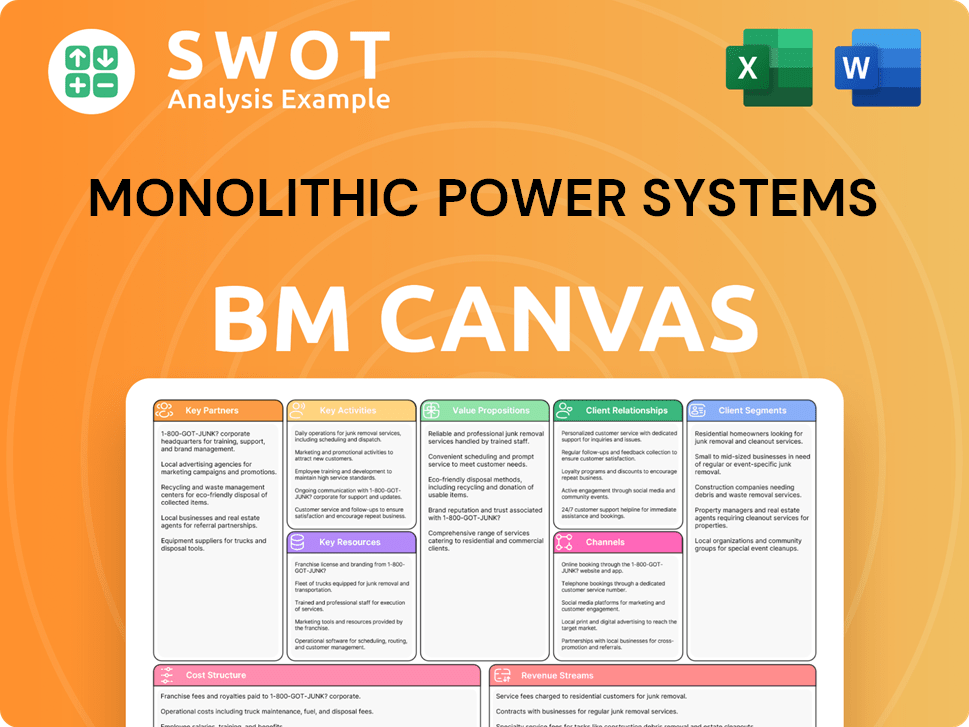
What Are Monolithic Power Systems’s Most Notable Campaigns?
The concept of 'campaigns' at Monolithic Power Systems (MPS) goes beyond traditional marketing efforts, encompassing strategic initiatives and product introductions that have shaped its growth. These 'campaigns' are instrumental in driving the company's sales strategy and expanding its market presence. The focus is on delivering innovative power management solutions for high-growth sectors, which is a key aspect of their marketing strategy.
A significant early 'campaign' was the introduction of a single-chip solution for CCFL backlighting in notebooks, which captured an impressive 80% market share by 2005. More recently, MPS's strategic focus on Enterprise Data and Automotive sectors has been particularly impactful. The company’s approach to sales and marketing is deeply intertwined with its product development and market focus, driving its overall performance and influencing investor relations.
MPS's ability to navigate challenges, such as the NVIDIA situation in late 2024, demonstrates the strength of its diversified strategy. The company's ongoing innovation and market diversification contribute to its long-term success, as highlighted in Brief History of Monolithic Power Systems. This resilience is a critical component of its sales strategy.
The Enterprise Data segment saw a remarkable 121.7% year-over-year revenue growth in 2024. This expansion showcases the effectiveness of MPS's power management solutions in supporting AI and server applications. In Q1 2025, revenue reached $188.5 million, up 77.7% year-over-year, indicating continued momentum.
The Automotive segment experienced robust performance, with Q1 2025 revenue up 66.4% year-over-year to $144.9 million. This growth reflects successful 'campaigns' focused on advanced driver-assistance systems (ADAS), body electronics, and infotainment. The 'mCar' demonstration platform is a key marketing initiative.
The 'mCar' platform is a product-centric marketing initiative. It showcases MPS hardware and motion control components in a real-world system. This allows for in-house testing and demonstrates the broad capabilities of MPS products. It's a key element of MPS's product promotion strategy.
MPS faced a challenge with NVIDIA in late 2024, potentially impacting market share. Despite this, the company's diversified strategy has proven resilient. The strong growth in other segments mitigates the impact of customer-specific issues, supporting its overall semiconductor sales strategy.
MPS's sales strategy focuses on innovation and market diversification to achieve sustained growth. The company's marketing strategy is closely aligned with its product development efforts, targeting high-growth sectors.
- Focus on high-growth sectors such as Enterprise Data and Automotive.
- Product-centric marketing initiatives, like the 'mCar' platform, showcase capabilities.
- Resilient approach to customer relationships, mitigating risks from any single client.
- Consistent revenue growth despite industry cyclicality, demonstrating the effectiveness of the long-term strategy.
Monolithic Power Systems Porter's Five Forces Analysis
- Covers All 5 Competitive Forces in Detail
- Structured for Consultants, Students, and Founders
- 100% Editable in Microsoft Word & Excel
- Instant Digital Download – Use Immediately
- Compatible with Mac & PC – Fully Unlocked
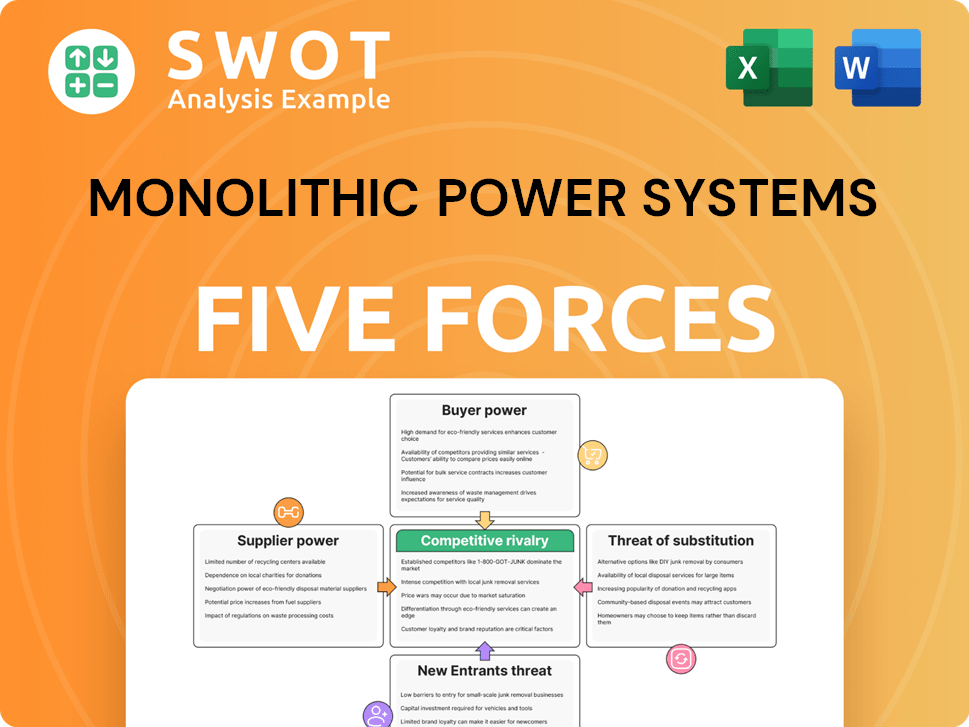
Related Blogs
- What are Mission Vision & Core Values of Monolithic Power Systems Company?
- What is Competitive Landscape of Monolithic Power Systems Company?
- What is Growth Strategy and Future Prospects of Monolithic Power Systems Company?
- How Does Monolithic Power Systems Company Work?
- What is Brief History of Monolithic Power Systems Company?
- Who Owns Monolithic Power Systems Company?
- What is Customer Demographics and Target Market of Monolithic Power Systems Company?
Disclaimer
All information, articles, and product details provided on this website are for general informational and educational purposes only. We do not claim any ownership over, nor do we intend to infringe upon, any trademarks, copyrights, logos, brand names, or other intellectual property mentioned or depicted on this site. Such intellectual property remains the property of its respective owners, and any references here are made solely for identification or informational purposes, without implying any affiliation, endorsement, or partnership.
We make no representations or warranties, express or implied, regarding the accuracy, completeness, or suitability of any content or products presented. Nothing on this website should be construed as legal, tax, investment, financial, medical, or other professional advice. In addition, no part of this site—including articles or product references—constitutes a solicitation, recommendation, endorsement, advertisement, or offer to buy or sell any securities, franchises, or other financial instruments, particularly in jurisdictions where such activity would be unlawful.
All content is of a general nature and may not address the specific circumstances of any individual or entity. It is not a substitute for professional advice or services. Any actions you take based on the information provided here are strictly at your own risk. You accept full responsibility for any decisions or outcomes arising from your use of this website and agree to release us from any liability in connection with your use of, or reliance upon, the content or products found herein.